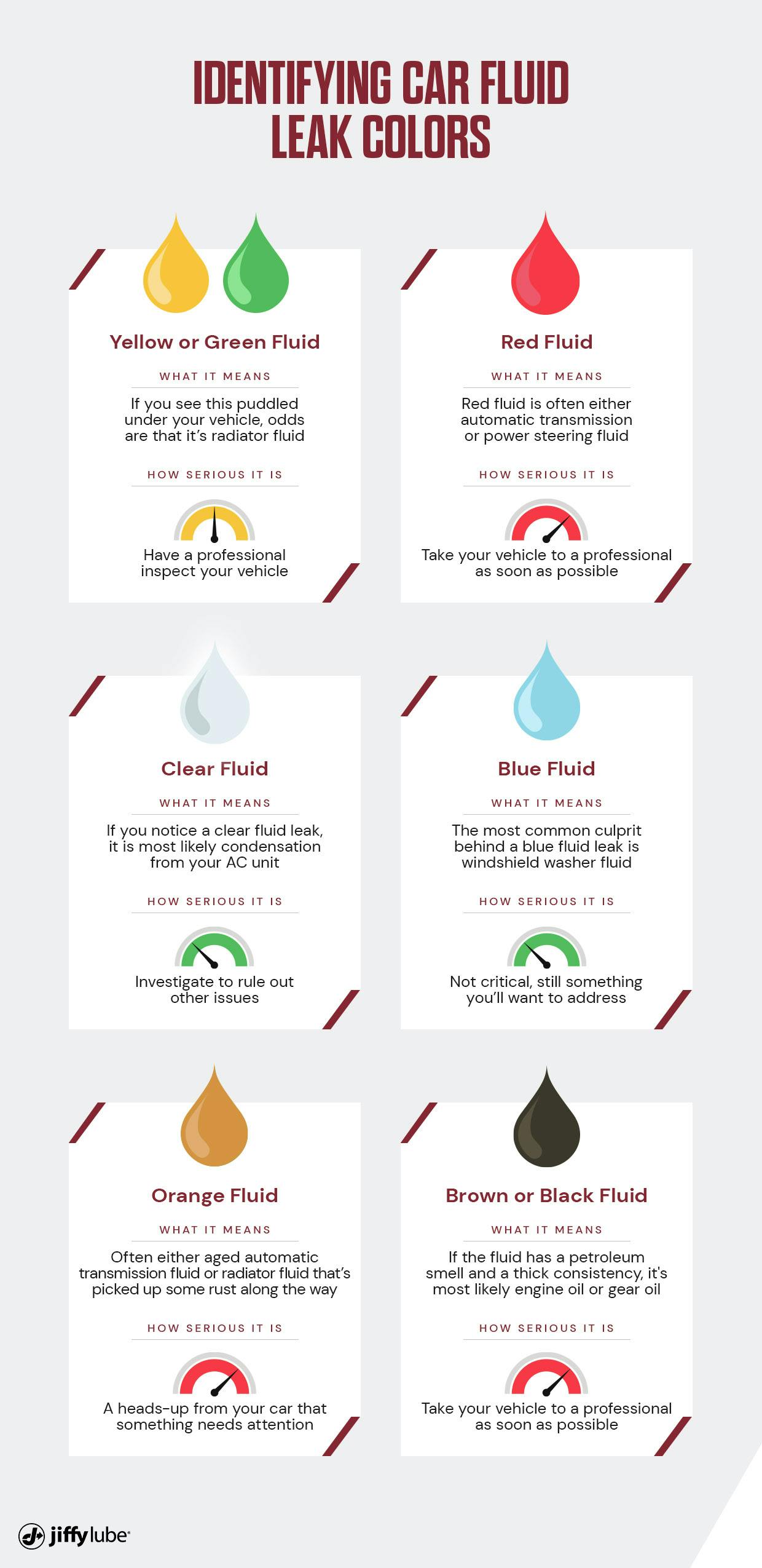
Spotting a puddle under your vehicle can trigger a wave of concern and confusion. What does the leak mean? How serious is it? And most importantly, what should you do next? Whether it's a harmless drip or a warning sign of a significant issue, understanding the nature of the fluid leaking from your car is crucial for maintaining your vehicle’s health and safety. Let’s explore the different car fluid leak colors and what they mean.
Yellow or Green Fluid Leaking from Car
If you see a puddle of yellow or green liquid under your vehicle, odds are that it’s coolant, which helps prevent your engine from overheating. Coolant — also known as antifreeze or radiator fluid — isn't just one color. Depending on the make and model of your vehicle, the fluid can be bright yellow, green, and sometimes even orange or pink. Coolant has a slimy feel and a surprisingly sweet smell. Usually, this colorful leak shows up right under where your engine sits.
If you're wondering if it’s actually coolant, there's a quick way to check. Pop the hood and find your coolant overflow tank, which is usually a transparent reservoir under the hood. If its level looks low or empty, that puddle under your vehicle is probably coolant.
You might be tempted just to top off the coolant and call it a day, but that's like putting a band-aid on a leaky pipe. Have a professional inspect your vehicle to find and repair the leak source. Ignoring this leak can lead to significant engine issues and expensive repairs as a result of an overheated engine.
Red Fluid Leaking from Car
Red fluid leaking from your car is often either transmission or power steering fluid. Both of which are vital to your vehicle's operation. Transmission fluid keeps your gears shifting smoothly without any hitches, while power steering fluid is the force behind your effortless steering. As the fluid ages, its color can range from a light red to a dark, almost brownish-red hue. It can also be thicker than engine oil and often has a sweet, burnt, petroleum-like smell.
So, how do you determine which fluid is leaking? Here's a quick tip to figure it out: If the leak is towards the front of your car, you're probably looking at power steering fluid. If the leak is located more in the middle or towards the back of your vehicle, transmission fluid is your likely culprit.
Regardless of which fluid is leaking, both can lead to more severe issues, including transmission failure or loss of steering assistance. Take your vehicle to a professional as soon as possible to identify the issue and repair the source of the leak. Better safe than sorry, right?
Clear Fluid Leaking from Car
If you've spotted a clear, water-like fluid under your vehicle, don't hit the panic button! Not all fluid leaks indicate your vehicle may be in need of service.
On hot days or whenever you crank up the air conditioning, it's perfectly normal for your vehicle to emit clear droplets. This is simply condensation from your AC unit. When the muggy air inside your vehicle meets the cold surfaces of the air conditioning system, water droplets form and eventually make their way to the ground, creating those puddles you see. It's totally normal and harmless.
If you notice a clear fluid leak, first ensure it's just water. Check the fluid's color, consistency, and smell. Pure water with no distinct smell is a good sign. It's just condensation. If the leaking continues when the AC hasn't been used for a while or if you notice the clear fluid in cooler weather, it might be worth further investigation to rule out other issues.
Blue Liquid Leaking from Car
The most common culprit behind a blue fluid leak is windshield washer fluid. This fluid is on the thinner side, much like water, and might give off a slightly soapy or alcohol-like scent because of its cleaning and antifreeze properties.
Now, where's this leak coming from? A few suspects are usually to blame. It could be something as straightforward as a loose connection in the washer system, a crack in the reservoir, or even a little tear or puncture in the tubing. Sometimes, overfilling the reservoir can also cause leaks, especially if the fluid expands on a hot day.
While a windshield washer fluid leak isn't as critical as other leaks, it's still something you'll want to address. After all, having a clear view of the road is essential for safe driving, and running out of washer fluid because of a leak can leave you in a sticky situation.
Orange Fluid Leaking from Car
Orange fluid leaking from your car can be a bit of a chameleon. It's often either aged transmission fluid or antifreeze that's picked up some rust along the way, pointing to potential corrosion in your radiator or cooling system. Fresh transmission fluid usually has a reddish hue, but can turn orange(ish) as it ages. Similarly, coolant, which starts out green, yellow, or pink, can turn orange if your cooling system starts to rust inside.
Whether it's transmission fluid or coolant turning your driveway orange, it's a heads-up from your car that something needs attention. Ignoring it can lead to bigger issues, like transmission problems or a cooling system failure, which can be big-ticket repairs.
Brown or Black Fluid Leaking from Car
If the leaking fluid is brown or black, has a petroleum smell, and has a thick consistency like syrup, it's most likely engine oil. Engine oil plays a critical role in lubricating the many moving parts within your engine, helping to reduce friction, and prevent overheating.
A few scenarios might lead to oil leaks. It could be something as simple as a worn-out gasket or oil filter that's not tight enough. Or, it could hint at something more serious, like a crack in the engine block or oil pan. High-mileage vehicles are particularly prone to these leaks as seals and gaskets lose their elasticity over time.
Oil is the lifeblood of your engine, so ignoring an oil leak can lead to severe engine damage, which is dangerous and expensive to fix.
Other Considerations to Keep in Mind
When diagnosing car fluid leaks, color is a fantastic starting point, but it's not the whole story. Here are a few other key factors that can help you understand what's happening under the hood (and under the vehicle).
● Location of the leak: The spot where you find the leak can offer clues about its source. For instance, a leak near the front of the car is often related to the engine or cooling system, while a leak towards the back could point to something in the transmission, rear differential, or exhaust system.
● Consistency and smell: Besides color, the thickness and odor of the leaking fluid can tell you a lot. Engine oil is thick and can smell a bit like petroleum, while transmission fluid is thinner and has a slightly burnt/sweet scent.
● Quantity of the leak: A small drip might not spell immediate disaster, but it's a sign that something's amiss. On the other hand, a significant puddle can indicate a more urgent problem, so keep track of how quickly the puddle grows.
● Changes in vehicle performance: Sometimes, a leak is just one symptom of a bigger issue. If you've noticed changes in how your car drives, such as difficulty steering, overheating, or strange noises, these could be related to the fluid leak.
Bring Your Vehicle to Jiffy Lube for Fluid Services
The best way to help avoid leaky surprises is to keep up with your vehicle's preventive maintenance. Regular automotive checks can catch small issues before they turn into bigger problems. If you're unsure about a leak or its source, you can visit your local Jiffy Lube® for fluid services where the trained technicians will provide a diagnosis and recommendation, helping save you time, money, and stress in the long run.
NOTE: Not all services are offered at all Jiffy Lube service centers. Please call ahead or visit jiffylube.com to ensure the service is available at the Jiffy Lube location near you.



